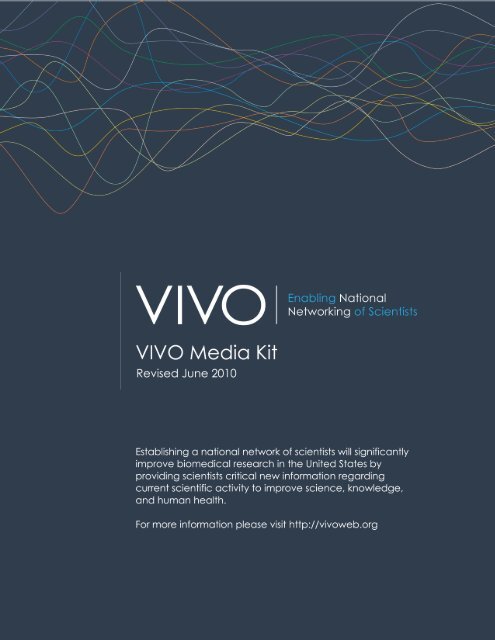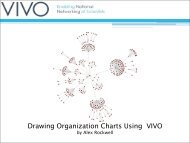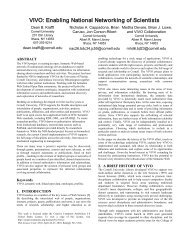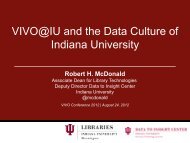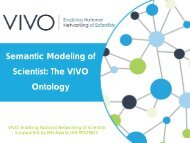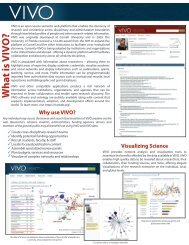Media Kit - VIVO
Media Kit - VIVO
Media Kit - VIVO
- No tags were found...
You also want an ePaper? Increase the reach of your titles
YUMPU automatically turns print PDFs into web optimized ePapers that Google loves.
How to Participate in the <strong>VIVO</strong> ProjectThere are at least three ways to participate in <strong>VIVO</strong>:123Adopter:Download, Adopt, and Implement: The open source <strong>VIVO</strong> software and ontology isnow available for download at http://vivoweb.org/download.Note that we are still early in the project, and we anticipate releasing new versions everyfew months. We welcome your feedback, however we are only able to provide directsupport to the seven partner institutions from the initial consortium for the <strong>VIVO</strong> project.Data Provider:You can participate by providing machine readable data for research discovery.Bibliometric and funding data are of great interest to the research community.Contact us at http://vivoweb.org/contact regarding ways in which you can contribute.Application Developer:Many software applications can benefit from using information that will be provided bythe national network. New applications can use information from the national networkto provide enhanced search, new collaboration capabilities, grouping, finding andmapping scientists and their work.If you have an application that could benefit from the national network, or have anidea for an application that would leverage the information provided by the nationalnetwork, contact us at http://vivoweb.org/contact.
<strong>VIVO</strong> National NetworkThe national network of scientists will facilitatethe discovery of researchers and collaboratorsacross the country. Institutions will participate inthe network by installing <strong>VIVO</strong>, or by providingsemantic web-compliant data to the network.The National Network will:• Link local <strong>VIVO</strong> installations and otherprofiling applications producing semanticWeb-compliant data.• Enhance cross-institutional collaboration.• Evolve in scale and scope to adapt to newpurposes and content.• Serve as a central portal for browsing andsearching research and scholarship atmultiple institutions.Features:• Profile information can be automaticallyimported from authoritative institutionaldata sources.• Individuals can log in using institutionalauthentication procedures to modify theirprofiles.• Information like research interests,publications, presentations, etc. can beeasily customized on the site.• Identify current work and find scientists withprecision and veracity.• Simplify reporting tasks and providevisualizations of personal networks.• Route information based on interests.Current <strong>VIVO</strong> collaboration:With <strong>VIVO</strong> you can:• Create cross-disciplinary research teams:Anthony Salvatorri is writing amulti-disciplinary research proposal on breastcancer. He would like to identify & contactpotential collaborators & begin to exchangeinformation regarding the research.• Recruit graduate students:Undergraduate Susie Gage is completing herBS in Biology. She wants to identify theuniversity with the best program in herresearch area of interest — the molecularbases of neurodegenerative disorders.• Locate focused publication content:Samantha Johnson is a faculty member atIndiana University. She is looking for paperspublished by IU scholars on using advancedstatistical methods to analyze researchimpact in the biomedical domain.• Assemble specialized review panels:Reed Worthy is a federal agency staffmember. He needs to identify people whocan serve on scientific review panels. Hewants people who work in specific scientificareas, but wants to exclude people whohave published papers with the peoplewhose proposals are under review.• Identify potential funding opportunity:Mary is the director of a largeresearch center. She would liketo visualize clusters of interests/techniques/areas of specialtyamongst the researchers that arepart of her center. She would liketo use this information to growexisting areas of strength andcollaborative efforts andmaximize ROI.This work is funded by the NationalInstitutes of Health, U24 RR029822.
Press Releases<strong>VIVO</strong> Utilizing Scopus Custom DataBy: Sandra Plasse & Jennifer SaundersSource: Elsevier (June 24, 2010)Sustaining the <strong>VIVO</strong> NetworkBy: Barbara BrynkoSource: Information Today - Volume 27, No. 6(June 24, 2010)Social Networking for ScientistsBy: IEEE Computer SocietySource: Computer - Vol. 43, No. 6 pp. 18 - 21(June 1, 2010)Tool <strong>Kit</strong> for Translational ResearchBy: Charlotte SchubertSource: Nature Medicine - Vol. 16 pp. 612 - 613(June 1, 2010)The Power of the Semantic WebBy: Barbara BrynkoSource: Information Today - Volume 27, No. 5(May 31, 2010)Social Networking in AcademiaBy: Sarah HuggettSource: Research Trends (March 1, 2010)Recovery Act Funds Fuel Innovative ResearchCollaborationsSource: NCRR Reporter - Volume XXXIV, No. 1(January 1, 2010)Networking in <strong>VIVO</strong>: An InterdisciplinaryNetworking Site for ScientistsBy: Virginia GewinSource: Nature - Volume 462, pp. 123(November 4, 2009)NIH funds a Facebook for ScientistsBy: Alice LipowiczSource: Federal Computer Week(October 26, 2009)A Question Of IdentityBy: Sophie L. RoynerSource: Chemical & Engineering NewsVolume 88, Number 21 pp. 36 - 37(May 24, 2010)Collaboration matchmaking in <strong>VIVO</strong>By: Miriam BoonSource: International Science Grid This Week(May 12, 2010)Science and the Stimulus EffectBy: Ciara CurtinSource: Genome Technology (May 1, 2010)<strong>VIVO</strong>: What’s Driving the DataBy: Barbara BrynkoSource: Information Today - Volume 27, No. 4(April 1, 2010)Subscribe to the<strong>VIVO</strong> News List athttp://vivoweb.org/contact<strong>VIVO</strong>: Connecting the .DocsBy: Barbara BrynkoSource: Information Today - Volume 27, No. 3(March 28, 2010)
Adoption of <strong>VIVO</strong>There are a number of challenges <strong>VIVO</strong> faces in facilitating adoption:Scientist vs. Administrator• What researchers want from <strong>VIVO</strong> can be very different from what institutions want.aFor example: At the University of Florida researchers are interested in CVs, biosketchesand collaborations. UF administration are more focused on faculty reporting needs –although they are also interested in increasing interdisciplinary collaborations. Findingcommon ground is important as we build the <strong>VIVO</strong> network.Research vs. Clinical CommunityaaResearchers: Early vs. established; enthusiastic, willing to participate.Clinicians: Less enthusiastic; “business” accumulated in other ways.• <strong>VIVO</strong> was developed primarily for a researching community – which has been enthusiasticand willing to participate. Enthusiasm may vary based on where a researcher is at in theircareer, but <strong>VIVO</strong> is generally welcomed. We are finding that the clinical communityis driven by different business needs.Innovators/Early Adopters vs. Early/Late MajorityaaInnovators & Early Adopters: Excited and willing to experiment.Early & Late Majority: Hesitant to adopt new technologies; <strong>VIVO</strong> takes work.Based on graph of adoption trends:• Innovators and early adopters areon the front end; and a smallamount of laggards on the backin, many of whom tend to beexcited about new technologies– regardless of marketing.• In the middle of this graph,however, we have early and latemajority, which includes 68% ofpotential adopters. Our challengeis to prove to people that it’sgoing to last and the return theyare investing is worth the effort.• One of the advantages of <strong>VIVO</strong> is the linkage with local data sources – reducing the effort ofindividuals who want to use <strong>VIVO</strong>.• Reaching their needs is crucial to <strong>VIVO</strong>’s success.
<strong>VIVO</strong> Individual Profile & ImplementationEach institution’s <strong>VIVO</strong> is populated withdetailed profiles of faculty and researchersdisplaying such items as publications, teaching,service, and professional affiliations.<strong>VIVO</strong> profile allows researchers to:• Illustrate academic, social, and researchnetworks.• Showcase special skills or expertise.• Establish connections and communities withinareas of research areas and geographicexpertise.• Summarize credentials and professionalachievements.• Publish the URL or link the profile to otherapplications.Profile information can be automatically importedfrom authoritative internal and external data sources.Other information like research interests, publications,presentations, etc. can be easily customized on the site.Much of the data in <strong>VIVO</strong> profiles is ingestedfrom authoritative sources so it is accurate andcurrent, reducing the need for manual input.• Private or sensitive information is neverimported into <strong>VIVO</strong>. Only public informationwill be stored and displayed.• Data is housed and maintained at the localinstitutions. There it can be updated on aregular basis.• The rich information in <strong>VIVO</strong> profiles canbe repurposed and shared with otherinstitutional web pages and consumers,reducing cost and increasing efficiencies.Data Sources Include:• Organizational data – Typically manually inputtedusing human resource files & existing web pages.• Demographic data – Acquired from local humanresource system, such as PeopleSoft. Dataelements include: name, email, title, etc.• Grant data – Ingest from local Office ofSponsored Research. Data elements include:grant title, institutional award ID, etc.• Publication data – Ingest from local institutionalrepositories or faculty activity directories. Datainclude: book /journal title, author(s), etc.• Course data – Ingest from local registrar system.• Faculty activity data – Ingest from local facultyactivity systems (research areas, etc.)• CVs and Biosketches – Manual input ofsupplementary data (research areas, etc.)• Profile Images – Ingest or manual upload• User input – Research interests, internationalactivities, verifying publications, etc.• Institutional Sources – Human resources (names,departments, titles), center and programaffiliations, phone book, etc.<strong>VIVO</strong> discovers researchacross an institution.See http://vivo.cornell.edu
Libraries Integration with the <strong>VIVO</strong> ProjectLibrary Staff as facilitators: Our ModelLibrary staff leverage theirtechnical and organizational skillsto facilitate in development andcommunication of their disciplines.They directly engage with facultyand researchers that also assistswith adoption, outreach, andidentify external data sources andpublishers.So what do library staff DO?Implementation• Identification of content types –ontology; development andinterface refinement.• Negotiation with the owners oflocal data sources to explainwhat data we need and why weneed it.• Create a home for <strong>VIVO</strong> processes andcontent management.Support/training• Provide local and national support andtraining through the development ofdocumentation, presentations and help-deskservices.Communication/liaising• Maintain web site (http://vivoweb.org) - thenational project site.• Engage with potential collaborators,participants via demos and answeringquestions.• Create a community of support via userforums.• Usability: Feedback, new use cases from usersto technical team.Why libraries?• Neutral, trusted institutional entities.• IT, information management anddissemination expertise.• Subject experts; experience in outreachand instructional roles.• Knowledge of institutional, research,instruction landscapes.• Service ethic; tradition of academicsupport.• Recognition of challenges posed by usercommunities.Marketing• Demonstrations, conferences, workshops andthe development PR materials designed bothto attract new participants and to assistparticipants with local adoption.
Quick Fact SheetGoal of <strong>VIVO</strong>:Improve science by providing the means forsharing and using current, accurate, and preciseinformation regarding scientists’interest, activities, and accomplishments.• Foster team science by providing tools foridentifying potential collaborators.• Improve collaboration by creating toolsusing this information for enhancing newand existing teams.• Facilitate team science.What is it?• Information regarding scientists’ interests,activities, and accomplishments.• Scientists using software tools based on thisinformation in new and existing teams.Why?• Support the acceleration of team science• Improve visibility (accuracy, currency,breadth) of information about science.• Improve competitiveness.How?• Institutionally hosted information provided &maintained by institutions and scientists.• Facilitation and support through the libraries.a <strong>VIVO</strong> is useful to many different users andaudiences. Users will come from within andoutside of the participating institutions.a <strong>VIVO</strong> can result in increased grant anddonor funding. For instance, the CornellAlumni Affairs and Development Office wascontacted by a major company interestedin making research funds available toscientists working on issues related tourology; a search in <strong>VIVO</strong> Cornell quicklyreturned several faculty in diversedisciplines working in this area, translating toreal dollars.a The technology is versatile and flexibleenough to easily accommodate changesbased on new and innovative demandsthat users make as they utilize <strong>VIVO</strong>.Functionalities & services proposedfor <strong>VIVO</strong> summarized as follow:• Ability to search/browse locally & nationallyto find people or topic-related expertise: Bykeyword, department, grants, geographicarea, authorship, publications & more.• Profile modification using institutionalauthentication system: Add or changeinformation ingested from institutionalauthoritative sources; display or hidesections from national view.• Ability to ingest data from authoritativesources: Including human resources, grants,course databases, faculty reportingsystems, etc.• Easy modification of core ontology: Useontology editor capabilities to accuratelyreflect local needs that might deviate fromthe Semantic Web for ResearchCommunities ontology bundled with eachlocal <strong>VIVO</strong> installation.• Delivery of data to consuming services andmobile devices: Including specializedunit portals, social networking/collaborativetool APIs, reporting tools and biosketches.• Networking: Create & share public/privategroups, adding or removing investigators to& from designated groups or contact lists.• Communication: Dynamically create andmanage listservs through external listmanagement tools.• Analytical capabilities & spatial mapping:Use multi-dimensional network analysis andvisualization techniques to analyzegroupings by publications, grants, fundingagencies, and expertise as determined bykeywords and concepts.


